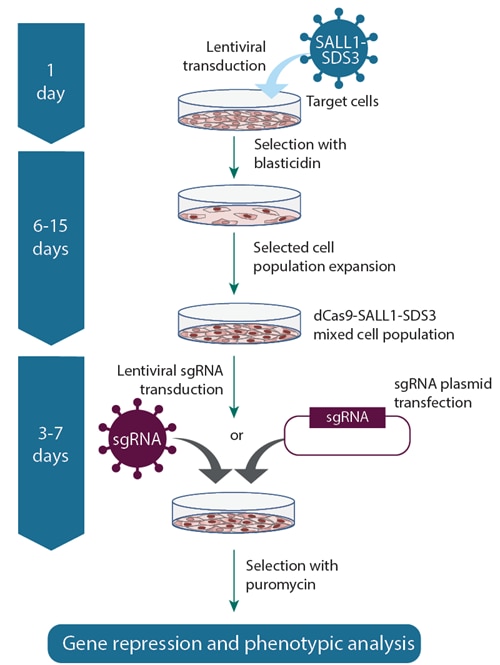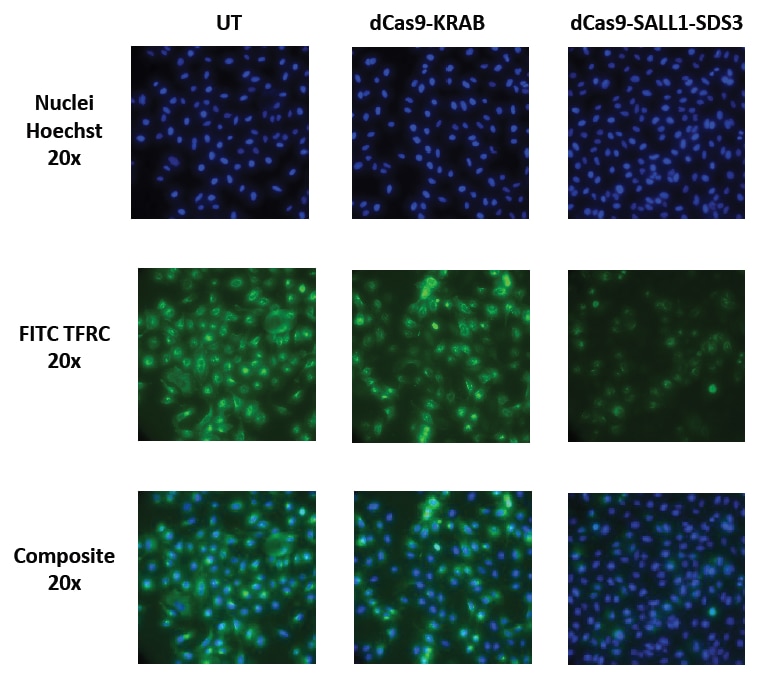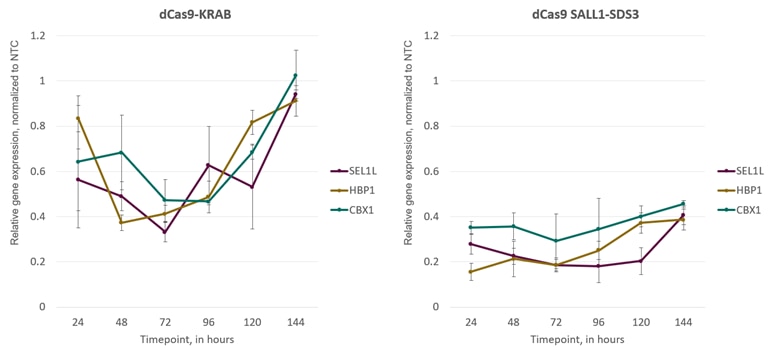- CRISPRi (CRISPR interference) 試薬
- dCas9-SALL1-SDS3 lentiviral particles
CRISPRmod CRISPRi dCas9-SALL1-SDS3 lentiviral particles

CRISPRi dCas9-SALL1-SDS3 lentiviral particlesは、独自の転写リプレッサー(SALL1およびSDS3)に融合した、ヌクレアーゼ非活性化Cas9遺伝子のヒトコドン最適化バージョンを発現します。ネイティブの転写開始部位の近くの遺伝子を標的とする適切に設計されたガイドRNAと組み合わせると、発現が抑制されます。
テクノロジーの概要はCRISPRiアプリケーションのページをご確認ください。
dCas9-SALL1-SDS3 lentiviral particlesのハイライト
- 独自の安定した’CRISPRi ready’のdCas9-SALL1-SDS3発現細胞株を作製します。
- 濃縮精製レンチウイルス粒子は、即時形質導入用のready-to-useです(qPCRによる最小1×107 TU/mL以上の機能力価)。
- ブラストサイジン耐性遺伝子の共発現により、dCas9-SALL1-SDS3導入細胞集団の選択が容易になり、個々の細胞のクローン増殖が可能になります。
- 使用細胞における最適な発現のために、3つの異なるプロモーターから選択できます(以下のオプションを参照)。
dCas9-SALL1-SDS3 lentiviral particlesを使用したCRISPRi実験に必要な試薬
- CRISPRi dCas9-SALL1-SDS3 lentiviral particles
- 標的遺伝子に対してデザインしたCRISPRi lentiviral sgRNA(ワークフローを参照)
すべてのRNA pol IIプロモーターが異なる細胞環境で等しく活性であるわけではない
dCas9-SALL1-SDS3の転写を制御するプロモーターの活性は、生物学的状況によって大きく異なる可能性があり、その結果、dCas9-SALL1-SDS3の発現レベルが変動し、遺伝子転写抑制のレベルが変動します。使用する細胞株に最適なプロモーターを選択することは、十分な遺伝子発現にとって重要です。
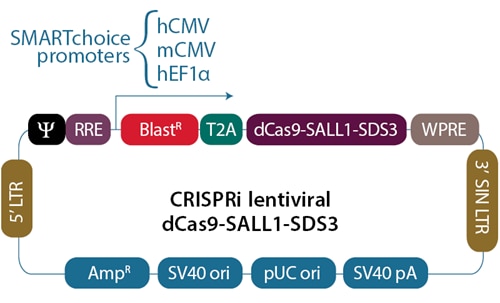
dCas9-SALL1-SDS3発現用のSMARTchoiceプロモーターオプション
| Promoter | Description |
|---|---|
| hCMV | human cytomegalovirus immediate early promoter |
| mCMV | mouse cytomegalovirus immediate early promoter |
| hEF1α | human elongation factor 1 alpha promoter |
化学合成sgRNAとdCas9-SALL1-SDS3 lentiviral particlesを使用したCRISPRiワークフロー
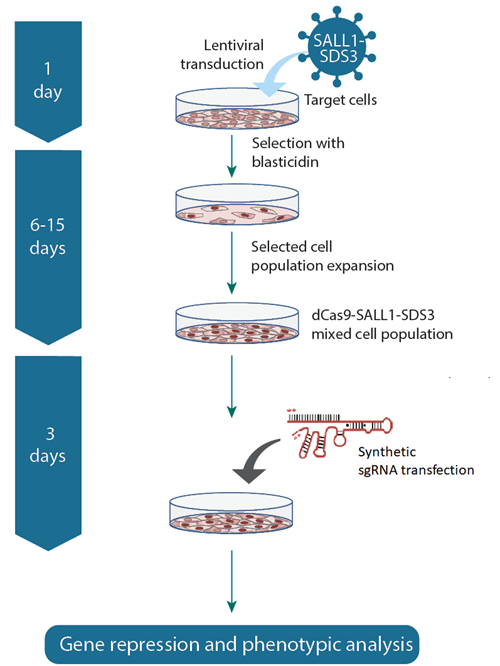
細胞にCRISPRi dCas9-SALL1-SDS3 lentiviral particlesを形質導入し、‘CRISPRi ready’のdCas9-SALL1-SDS3安定発現細胞株を作製します。次に、ターゲット遺伝子に特異的なCRISPRi化学合成sgRNAを導入します。このシステムは、トランスフェクション可能な細胞モデルでのアレイ化スクリーニングに最適です。
lentiviral sgRNAとdCas9-SALL1-SDS3 lentiviral particlesを使用したCRISPRiワークフロー
CRISPRi dCas9-SALL1-SDS3 lentiviral particlesを使用して安定したdCas9-SALL1-SDS3発現細胞株を確立し、CRISPRi lentiviral sgRNA粒子(左)またはプラスミドsgRNA(右)を導入するワークフローです。このシステムは、トランスフェクションが難しいタイプの細胞を扱う場合に理想的です。
dCas9-SALL1-SDS3を使用したCRISPRiは、dCas9-KRABを使用したCRISPRiよりも強力なタンパク質レベルの抑制をもたらす
TFRCの機能的ノックダウンは、hEF1αプロモーター下でdCas9-KRABまたはdCas9-SALL1-SDS3のいずれかを構成的に発現するU2OS細胞で評価されました。TFRCを標的とする3つのCRISPRi synthetic sgRNA(化学合成sgRNA)のプールフォーマット25 nMを、DharmaFECT 4トランスフェクション試薬を使用して、細胞にトランスフェクトしました。トランスフェクションの72時間後に細胞を分割し、96時間後に細胞を固定し、TFRCを標的とする一次抗体とAlexa Fluor488標識蛍光二次抗体で染色しました。核の同定にはヘキスト染色を使用しました。
dCas9-SALL1-SDS3発現細胞は、dCas9-KRABと比較して、より大きく、より一貫性のあるCRISPRi遺伝子転写抑制を示す
CRISPRi化学合成sgRNAは、dCas9-KRABおよびdCas9-SALL1-SDS3発現細胞の両方で、トランスフェクション後48〜72時間で最大の転写抑制を達成します。dCas9-KRABまたはdCas9-SALL1-SDS3を安定して発現するU2OS細胞を、10,000細胞/ウェルでプレーティングし、CBX1、HBP1、またはSEL1LをターゲットとするCRISPRi synthetic sgRNA(化学合成sgRNA)のプールフォーマット25 nMを DharmaFECT 4トランスフェクション試薬を使用してトランスフェクトしました。24、48、72、96、120、および144時間後に細胞を回収し、全RNAを単離し、RT-qPCRを使用して相対的な遺伝子発現を測定しました。各標的遺伝子の相対的発現は、ハウスキーピング遺伝子としてGAPDHを用いたΔΔCq法で計算し、non-targetingコントロール(NTC)に対して正規化しました。
LentiBOOST Lentivirus Transduction Enhancer is a uniquely formulated transduction reagent that can be used with or without lentivirus spinfection in order to increase successful viral transduction events while preserving cell viability. Especially critical for preserving precious primary cells from patient cohorts, or, for engineering complex animal models; improving transduction efficiency can save time and costs by increasing the success of each editing/transduction step, or, even avoid the loss of irreplaceable samples. Additionally, LentiBOOST technology is already used in the manufacturing of a number of clinical stage therapies providing the opportunity to demonstrate improved workflow applicability to the clinic.
LentiBOOST can be purchased through the Dharmacon Reagents catalog.
To learn more about LentiBOOST technology visit the Revvity LentiBOOST webpage.
Supporting Data
Improved CD8+ T-cell SMARTvector™ shRNA lentiviral system transduction using LentiBOOST™ Lentivirus Transduction Enhancer

100,000 primary human CD8+ T cells were transduced with either 30,000 (MOI 3, green) or 70,000 (MOI 7, purple) TUs of SMARTVector™ mCMV tGFP Lentiviral Control Particles targeting either NTC or PPIB along with 1:100 LentiBOOST transduction enhancer. Cells were centrifuged at 800 x g for one hour at 32 °C followed by a four hour incubation prior to removal of lentiviral particles and transduction enhancer. Transduction efficiency (%GFP+ out of live cells) and viability were determined 5 days post-transduction by flow cytometry. The addition of LentiBOOST technology markedly improved transduction efficiencies without significantly impacting cell viability.
Improved CD4+ and CD8+ T-cell Edit-R™ All-in-one sgRNA/Cas9 lentiviral system transduction using LentiBOOST™ Lentivirus Transduction Enhancer
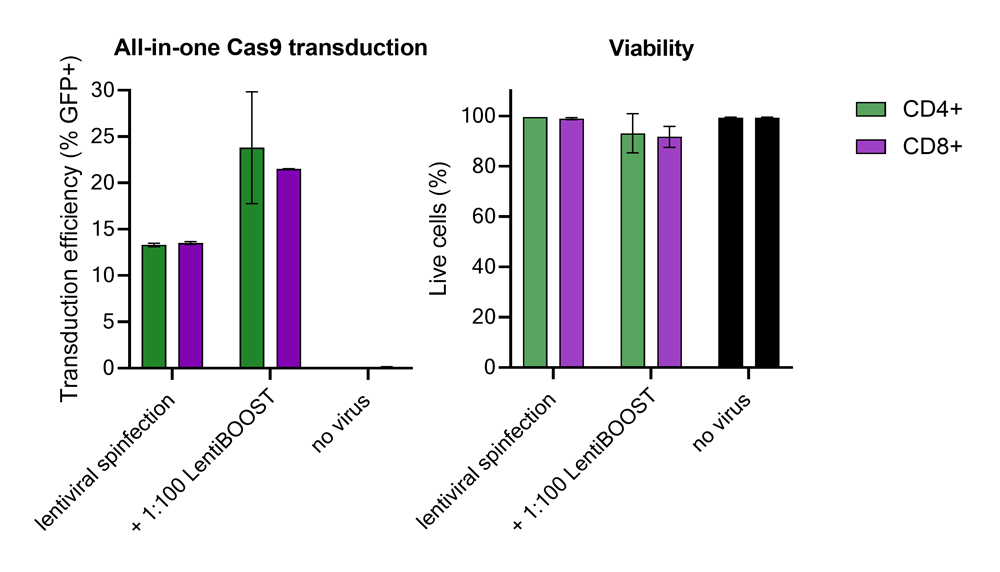
100,000 primary human CD4+ and CD8+ T cells from two donors were transduced with 250,000 TUs of Edit-R GFP Delivery controls mCMV along with 1:100 LentiBOOST transduction enhancer. Cells were centrifuged at 800 x g for one hour at 32 °C followed by an overnight incubation prior to removal of lentiviral particles and transduction enhancer. Transduction efficiency and viability were determined 72 hours post-transduction by flow cytometry. The addition of LentiBOOST technology markedly improved transduction efficiencies without significantly impacting cell viability.
Improved transduction of human induced pluripotent stem cells (hiPSCs) with the Strict-R™ Inducible CRISPRa lentiviral system transduction using LentiBOOST™ Lentivirus Transduction Enhancer

10,000 WTC hiPS cells were transduced with either 20,000 (MOI 2, green) or 40,000 (MOI 4, purple) TUs of Strict-R™ Inducible EGFP dCas9-VPR Lentiviral Particles along with 1:100 LentiBOOST transduction enhancer. Cells were centrifuged at 800 x g for one hour at 32 °C followed by an overnight incubation prior to removal of lentiviral particles and transduction enhancer. Transduction efficiency and viability were determined 72 hours post-transduction by flow cytometry. The addition of LentiBOOST markedly improved transduction efficiencies without significantly impacting cell viability.
Protocols
Safety data sheets
Selection guides
Related Products
遺伝子転写抑制実験の最適化のための検証済みCRISPRi lentiviral sgRNA
LentiBOOST transduction enhancer can increase successful viral transduction in challenging to transduce cells, or, complex cellular engineering work; while preserving cell viability and minimizing the amount of viral particles required for your experiment. LentiBOOST technology is actively used in the production of clinical stage lentivirally delivered therapies, including some approved therapies, providing a direct path to therapeutic applicability for your research studies. Tested with Dharmacon Lentiviral reagents.

